The Canvey Island Urban District Council
1926-1974
We have recently been loaned a copy of the ‘Urban District of Canvey Island 1926-1974 Official Guide’. This was produced in 1974 after the amalgamation of the Council with the Councils on the mainland. This is just part of the information contained in the guide, a potted history of the Council from 1926-1974. Other interesting pages will be added soon.
~~~~~~~~~~~~~~~~~~~~~~~~~~~~~~
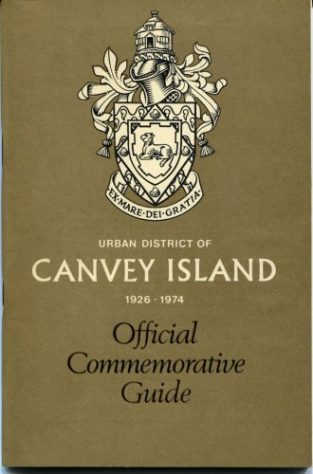
Urban District of Canvey Island Official Commemorative Guide
The Canvey Island Urban District Council first came into existence on the 7 April, 1926, as a result of the statutory powers contained in the Public Health Act, 1894, and ceases to exist as a result of the Local Government Act, 1972, on the 31 March, 1974. On that date Canvey Island will then merge with its neighbour the Benfleet Urban District Council to form a new district of Castle Point.
These notes are intended to be a short history of the Canvey Island Urban District Council’s progress and achievements and is in no way intended to be a history of Canvey Island. If the reader desires to read a History of Canvey Island, they are referred to the many authoritative works issued over the years by Professor Cracknell and other eminent writers. These notes are based on records contained in the Minute Books of the Council supplemented by information supplied by the “Father of the Council”, Councillor George Ambrose Pickett.
Prior to its inception as an Urban District Canvey Island had its own Parish Council, in its own right as a parish of the Rochford Rural District Council; the first meeting of the Canvey Island Parish Council being held on 18 December, 1894, with five parish councillors, namely, Charles Beckwith, James Sash, Rev. Henry Hayes, William Smith and James Cass, all having been elected at a Parish Meeting in the school room on the 4 December, 1894. The first Parish Clerk was Mr. C. E. Judd.
From a study of the early records, the Parish Council apparently concerned itself with such matters as the state of a public well, the possibility of a water supply, public recreation ground, telegraphic communications with the mainland, footpath, ditches, educational matters, the provision of a ferry, public lamps, flooding, the sea wall, allotments and the possibility of a bridge linking Canvey Island with the mainland. Perhaps the greatest controversy, and possibly their greatest achievement, was the provision of a new school. In 1894 the only educational establishment was a parish school which was a timber framed building opposite St. Katherine’s Church. This building later became the parish hall and is now demolished and is the site of Village Hall Close. On 1 May, 1922, the Parish Meeting considered the question of a site for a new school for Canvey Island, and Mr. George Chambers who was then the Chairman of the Parish Council together with Rev. Green and some 50 residents held a special meeting under the chairmanship of Rev. Green and Mr. Chambers offered to give a site for a central school, either Little Gypps North or Little Gypps South upon the condition that the Education Authority built the school within one year. The meeting chose Little Gypps North on the grounds that this was the most central. The school was eventually built in 1925 to house 200 to 300 pupils, and was later known as the Long Road Council School, and subsequently the William Read School. This building has in recent years been demolished and the site redeveloped with the William Read Junior and Infants Schools.
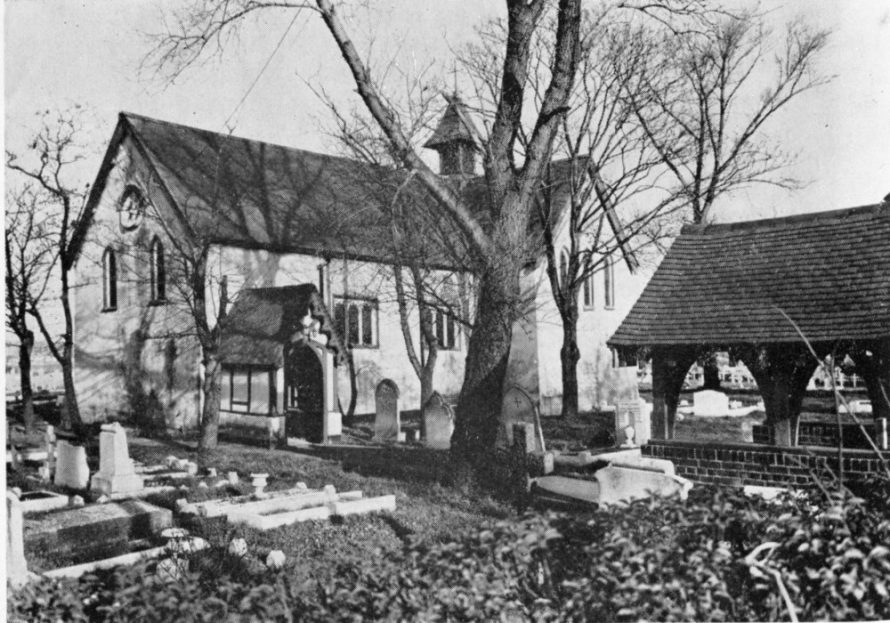
St Katherine’s Church
Although, of course, Canvey had its Parish Council in those days the centre of administration was at Rochford as Canvey was part of the Rochford Rural District Council. The inhabitants at that time felt that in many instances little attention was being given to events on Canvey Island, and that Rochford was too remote. It should be remembered that at that time there was no gas or electricity services and the only water supply was from the pump at the Village, and the only road was a poorly metalled one on the top of what was a counterwall (now Canvey Road, Long Road and High Street). Cooking was mainly by paraffin as was lighting. Water for all purposes was rainfall collected in water butts from the roof and sanitation was by earth closet. It was not unnatural that the inhabitants should feel that they wanted urban status in order to more quickly improve their amenities.
It is also interesting to note that in the light of present day controversies surrounding the establishment of oil refineries and the industrialisation of the Island that even in those days there was a proposal to construct docks with a rail link in the south west corner of Canvey on the site of what was then called Brick-house Farm because it had deep water frontage. A private Bill was promoted in Parliament to this effect but largely due to the opposition of the Port of London Authority who wished to develop Tilbury, the Bill was defeated.
In 1925 the County Council adopted a recommendation of a Local Government Committee recommending that the Parish of Canvey Island became an Urban District. In consequence the County Council made the necessary orders in consultation with the Minister of Health which Order was sealed in January 1926 and thus Canvey Island became formally constituted as a new Urban District. Their first meeting was held on 7 April 1926, the Councillors being Messrs. Ansell, Bensley, Chambers, Delaway, Frahcke, Hertfield, Miss James, Leach and Thompson.
The Council engaged the services of the then Town Clerk of Tilbury, Mr. Buckner, and Mr. Hith-Willis, the Engineer and Surveyor to the same Authority to advise them of the priorities needed to bring Canvey Island up to date. The first Clerk to the new Urban District was a part time appointment occupied by Mr. H. O. Bigg, as a result of public advertisement, at a salary of £100 p.a. Other appointments were Dr. Wheatley as Medical Officer of Health and Mr. C. E. Flooks as Surveyor, Sanitary Inspector and Building Inspector.
These gentlemen decided that the first major project should be the reconstruction of the old road. It is interesting to recall that even in the old days there was bitter controversy over this project and much argument ensued between the section of the community that was in favour of the scheme for the reconstruction of the old road and those in favour of a shorter new road route, through the Winter Gardens. The Council decided on the reconstruction of the old road and were immediately involved in claims for compensation for the acquisition of land for road widening purposes inasmuch as the plan was to lower the counterwall by some 4/5 feet and construct a 20 feet wide carriageway with 2 feet 6 inches paths and surface water drainage. The contractors were Messrs. Chitterton and Simmonds of Maidstone. The cost was £90,000 and the work commenced at Lakeside Corner by a ceremony performed by Miss Clara James who was a Councillor and Justice of the Peace who served Canvey Island faithfully and well during her very long life. The road was taken over by the Essex County Council on completion.
Having resolved the road problem the next major project was the building of a bridge across the Creek separating Canvey Island from the mainland. This was necessary because at low tide the only access was a causeway and then a narrow strip of road some 9 feet wide flanked on either side by mud. Not unnaturally many vehicles ran off the road and were submerged by the incoming tide. When, of course, the tide was in the only access was the ferry which could be a hazardous operation particularly at night. The causeway had its commercial use in that the soil of Canvey was very suitable for the growing of hay which crop was in demand by racing stables, and this crop was loaded on to wagons and then on to barges operating from this causeway. The Leigh Building Supply Company also had a wharf where ballast drawn from the bed of the Thames was loaded and delivered to building construction firms. However, attractive and desirable these commercial operations could be the Council decided in 1929 that the time had come to build a bridge and in the light of controversy of more modern times it is interesting to know that their first plan was for a high level bridge, at a cost of £150,000. As the penny rate product was only £40 the Council decided it was too dear and engaged a consultant Mr. Gerald Dean of Victoria Street, London, to design a more modest structure. This was duly produced as an opening bridge operated by electric motors. The contractors were Messrs. Farr and Co. Ltd., their price being £20,000 including the approach road and the work commencing in 1930.
Another priority given by the early Council was to the foreshore which they were anxious to acquire for the public, particularly that section from May Avenue to Thorney Bay, the freeholders of which were Jesus College, Cambridge, and the tenant the A. M. Clarke Estate. After a public inquiry the Council were successful in obtaining the freehold of an area of land 100 feet in width from the toe of the sea wall at Deadman’s Point to May Avenue, including the area now known as Labworth Park from the A. M. Clarke Estate for the sum of £4,000.
Life, of course, in those early days was not particularly easy for the inhabitants due to the unmade roads and the lack of services, and it was not unusual for goods to be delivered with horse and sledge. Rubber boots, torch and hurricane lanterns were, of course, necessities. The health of the community was looked after in those days by Doctors Barber, Wheatley, Wilkes. Corbett and Stevens and the Midwife Nurse Tibbles, the mother of our present vice Chairman. This era also produced our first chemist, Mr. Venables. In an endeavour at least to try and ease the lot of the people trying to get to the Station, the Council laid a duckboard track from Lakeside Corner through Central Wall Path to Waterside Farm. It was often quite a hazardous journey to use this track in the winter months and this project was also the Council’s first effort at street lighting in that they were instrumental in installing three oil lamps along this path.
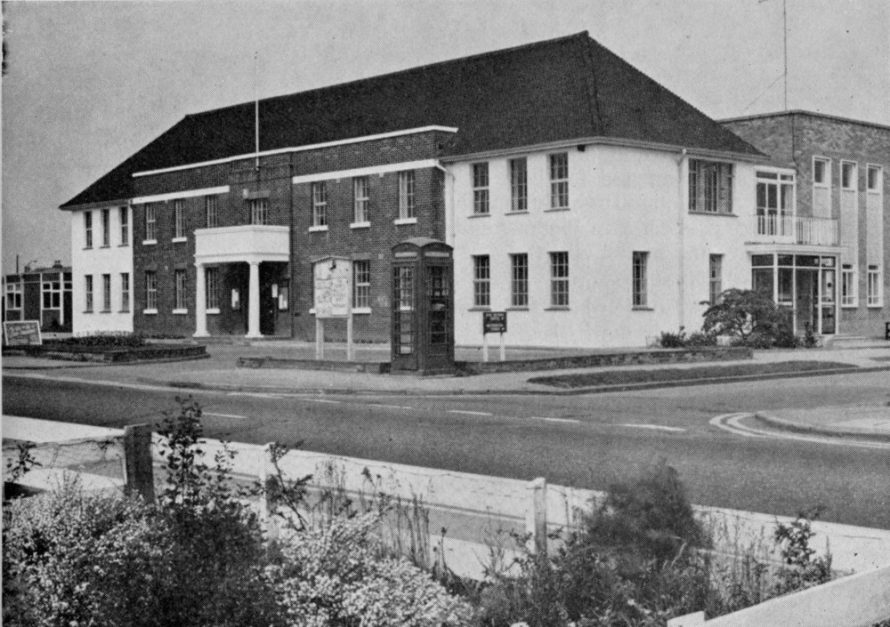
Council Offices, Long Road
Although the Parish Council had met in the old village school this was not available for the Urban Council Meetings and the first Council Offices was a bungalow named “Fairlawn” at the junction of Long Road and Fairlop Avenue which was rented. The Council itself met in a room in this building measuring 14ft. x 15ft. with a fireplace at one end and a mantelpiece. Two tables, one against the other, were placed on blocks of 4 x 4s to give them height and three paraffin lamps supplied the lighting. Councillor George Pickett, who is a member of the present Council and was in fact a Member of the Council in those days relates one of his favourite anecdotes — on one occasion at a meeting in “Fairlawn” a certain member always sat by the side of the fire on meeting nights and always had a large scotch and dry brought in which was placed on the mantelpiece. One night a heated argument broke out, the tables fell off the blocks, the lamps went out and confusion reigned. When order had been restored the Councillor raised a point of order in that his scotch and dry was missing!
Eventually the Council decided to build its own offices to house not only the administration but also the fire brigade and the ambulance, both of which were run on a voluntary basis — the fire brigade under Mr. Benwell and the St. John Ambulance under Sister Bertha Wade. The Council Chamber and Administrative Offices were in the central block with the ambulance station in the west wing and the fire brigade in the east wing. Although the two wings have since been adapted for office accommodation the main building remains today as it was built, with the additions which have been added on since.
Canvey Island was, of course, a great centre in the pre 1939 war years as a day tripper and holiday resort for the people from the East End of London. It was not unusual to see people camping in many parts of the Island. Its popularity as a weekend and summer holiday centre brought an influx of people desiring to live permanently on Canvey and estates began to develop, two estate developers in those years being Messrs. S. Fielder and Son, the owner of which was the late Mrs. Susan Fielder. The business passed to her son who is now Col. Fielder and who was for many years an active and leading member of the Council and served the district faithfully and well. One of the other principal estate developers was Mr. Frederick Fisk, whose wife Edith was very prominent in social work on Canvey Island and was a Member of the Council for many years and at one time Chairman.
It will be seen that Canvey Island was gradually taking shape and the Council was doing its best to endeavour to discharge its functions of improving the lot of the community, particularly by bringing in basic services. Water provided by the old Southend-on-Sea Waterworks Company who laid many miles of water main along the roads, but in many instances this was only possible where the Council were prepared to guarantee the income to the company until there were sufficient properties connected to the main to make it an economic proposition. The Council were also negotiating with the former Gas Light and Coke Company for the provision of gas mains and with the Electricity Board for electricity. Therefore the Council were able to provide a limited form of either gas or electricity for street lighting in some of the roads. Refuse collection was, of course, a vital service but was a problem with the scattered community. The Council decided to operate its first refuse collection service by placing a large number of big bins at various places which were then emptied from time to time. The idea was for people to take their refuse and place it in the bins. This, of course, created the problem that when the bin was full the people just put the refuse opposite the bin. The bins were in fact collected and emptied weekly and the contents deposited on a piece of land at the end of Denham Road which was owned by Mr. George Chambers. The contractor was a very well known Canvey resident, Mr. Vic Scott who in turn employed another well known Canvey figure, Arthur Read. The contract sum was in fact £79 p.a.
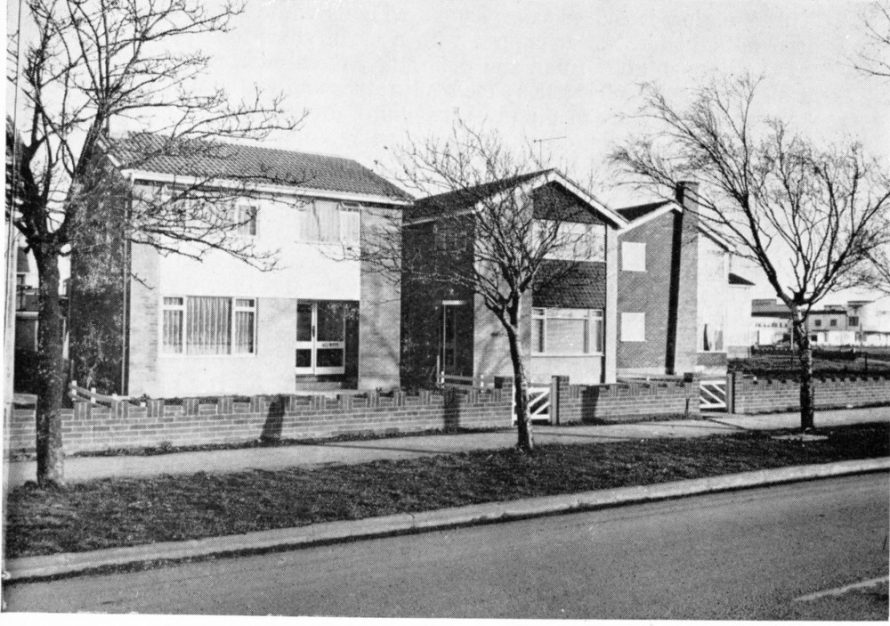
New Houses in Furtherwick Road
The Council were anxious to improve not only the refuse collection but also the other amenities on the Island such as roads and above all provide a sewer. After the main road the next major road improvement was Furtherwick Road which in the late 1930s was a farm track with a gate approximately where the block of buildings now stand housing the Ministry of Social Security and offices. The Council constructed a highway along this farm road from Haystack Corner to the sea front at Labworth. By this means they were also able to improve the access along the toe of the sea wall itself by the provision of the Eastern and Western Esplanades. The problem facing them, however, was in the provision of a sewer which was very complicated in that Canvey Island being so flat there was no fall and eventually they constructed the system itself with little or no fall, based on a series of pumping stations situate at Leigh Beck, Furtherwick Road and Long Road. In latter years the Council have, of course, considerably extended and improved this system. The modern sewage disposal plant was opened in 1967 and sited at the end of Thames Road. This plant was based on the Inka method which was developed in Sweden and prior to this construction the Council sent a party of Councillors and Officers to study the method at first hand.
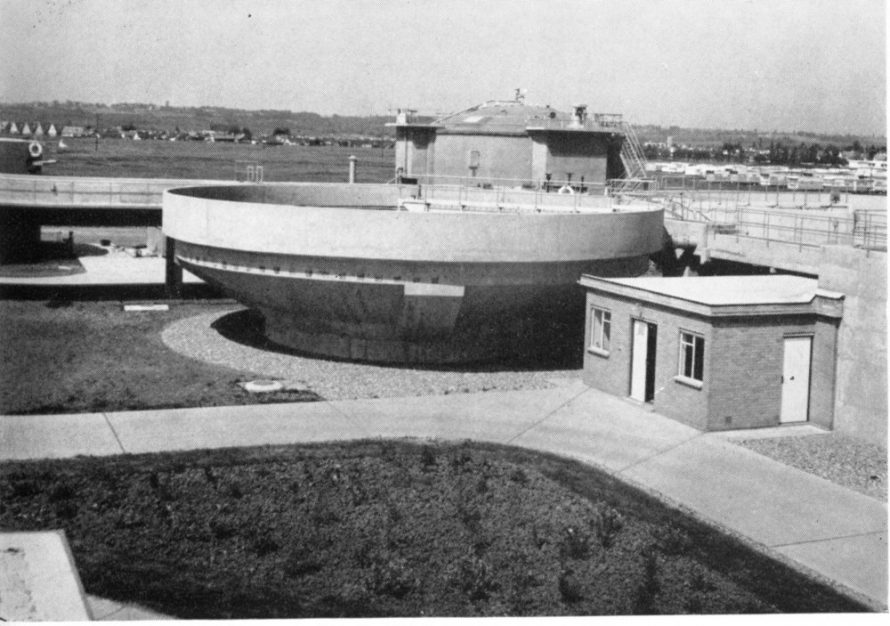
The new Sewage Plant
From its earliest days the Island has, of course, relied for its protection from encroachment from the sea on the sea wall, and the reader is referred to the very excellent publications which have been produced over the years on the work that was involved in the construction and maintenance of the sea wall. Suffice it here to say that the Urban District Council have never been the Authority responsible for the provision and maintenance of the wall, this being originally devolved on a special body known as Canvey Island Commissioners. In later years their duties were taken over by the Essex River Board and now the Essex River Authority. The Council naturally took a great interest in the sea wall and in the 1930s were concerned at people taking shell from the beach. It should be noted that the shell from which the name Shellbeach was derived was quite fine and is useful for many purposes. The Canvey Island Commissioners were forced to take High Court action to prevent people from taking shell from this beach. The Council were anxious that the residents should have access to the sea wall at all times and over the years have fought for the top of the sea wall to be a public right of way and today this right is preserved by the inclusion of the top of the sea wall on the public rights of way map under the National Parks and Access to the Countryside Act, 1948. The sea wall has been breached several times over the centuries by the encroachment of the sea, and in 1885 the old wall gave way at one or two points and the Commissioners were required to construct a new sea wall. The construction of the sea wall in some places was farther in than the old sea wall and as a result in one or two places, particularly at Kynochs and Shellbeach, there was land between the old and the new sea walls. The piece at Kynochs was leased by the Commissioners to the Canvey Island Council.
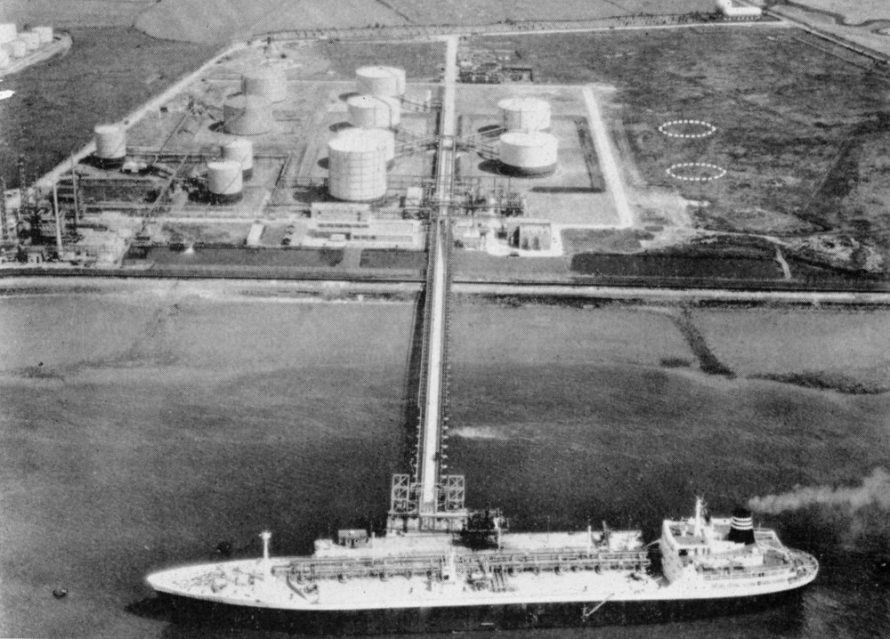
Aerial View of the Methane Terminal
In 1931 began the “industrialisation” of Canvey by an application by Mr. Anfillogolf to establish an oil refinery and storage on the land owned by the Port of London Authority, at Brickhouse Farm. This proposal met with fierce opposition by the then Council and a public inquiry was held at which such eminent figures as Sir Stafford Cripps, K.C., Mr. Schofield, K.C., and Mr. Glenn appeared among many others. The Minister allowed the development for oil storage only but ruled that no refining was to take place. Even then it was not all plain sailing for Mr. Anfillogoff in that he then submitted plans showing jetties projecting out into the deep water and the Council refused consent on the grounds that these jetties crossed the land between the old and new sea walls which they leased from the Commissioners. The Port of London Authority did not take kindly to this as they argued that they owned the land as a result of the powers vested in them when the Port of London was first constituted. This resulted in a High Court action by the Council and after a three day hearing Mr. Justice Eves gave a decision in favour of the Council. The Port of London Authority appealed to the House of Lords who decided that the land in question belonged neither to the Council nor the Commissioners but to the original owners or successors in title, the last conveyance of this land being in 1813. As the owner could not be traced the Port of London Authority were in fact forced to serve a Compulsory Purchase Order.
Over the years, of course, the Council have recognised the importance of the sea wall as a sea defence and in 1953 the Island suffered most grievously as a result of the East Coast Flood Disaster. The wall was breached in a number of places and as a result a large part of the Island was flooded and eventually the decision was taken to evacuate the whole Island. This, as can be imagined, threw a tremendous burden on the Councillors and Officials. It is not a part of these short reminiscences to go into details of these events and the reader is directed to such authoritative works as The Great Tide by Hilda Grieves the County Archivist. Suffice it to say that at the time and indeed over subsequent years many tributes have been paid to the work performed by Members of the Council and Officials during that tragic event, and particularly the work of Major R. H. Stevens, C.Eng., F.I.Munn.E., the Engineer and Surveyor to the Council. After the immediate emergency had passed there remained the problem of the repair of the sea wall, but this was the responsibility of the Essex River Authority and not this Council. The Government of the day set up a Committee under Lord Waverley, hence the name The Waverley Committee, who recommended standards for new sea defences after the 1953 floods. The Essex River Authority adopted these recommendations for the new sea defences of Canvey Island and spent £1 million on improving and strengthening the sea wall. As the reader can well imagine after such a disaster confidence in the Island was at its lowest ebb and Councillors saw its primary task of restoring this confidence both in respect of the private individual and the business and industrial community. While stories were circulated at the time of land and property changing hands at ridiculous prices and exaggerated as they may be there is no doubt that this lack of confidence had resulted in a tremendous drop in land and house prices on Canvey Island. Consequently the Council felt that their first task was in the restoration of confidence, the stabilisation of prices and they readopted the provisions of the Small Dwellings Acquisition Acts which they had tried before the 1939/45 War but had abandoned because the scheme did not operate particularly well. Under these Acts the Local Authority were empowered to lend money under mortgage for house purchase. In 1953 the Council adopted a very liberal mortgage policy, and subsequently they continued this policy by adopting the lending powers contained in the Housing Acts as these were rather wider than in the Small Dwellings Asquisition Acts. Over a period of seven years the Council lent in between £1 million and £1 1/2 million for house purchase which was a very considerable sum bearing in mind the relatively small population and rateable value then existing. The sum was comparable to that lent by many small Building Societies in the country. However, the Council’s policy succeeded and the seal of confidence was placed in the Island when the then London Boroughs of Dagenham and Walthamstow joined with the Canvey Council to build an estate just off Long Road at the rear of the Roman Catholic Church consisting of some 220 properties to house the overspill population from their two districts. The Council is proud of this development and regards it as one of the finest forms of municipal housing in the country.
Canvey Island has always been keen of its social life and the Council has always been closely indentified with the cultural and social activities on the Island. In the early 1930s these social activities were based on the social clubs which were then in abundance, particularly the Small Gains Club which was owned by a local well known character, H. Price Powell, who with his monocle placed firmly in position was one of the many local characters that inhabited the district at the time. Another well known club was the Canvey Club which was owned by another well known person, Mr. Scott, and the Rendezvous operated by Jimmy Went. One should not forget the Premier Club operated by Dave Williams or the two clubs at the Point which were operated by the King Brothers. For those who did not wish to find their social company in the clubs there was the Whittier Hall at Leigh Beck which in the early 1930s operated such activities as billiards, table tennis, chess and competitions to be champion at any of these events was very keen. The highlight of the week was the Magic Lantern Show run for children for which admission was a halfpenny. Mr. and Mrs. Thomas ran Whittier Hall with a willing band of helpers and many of the old Islanders are I am sure grateful for the facilities afforded at Whittier Hall. For the more sophisticated there was Bohemia Hall which held various social activities and again the highlight of the week at this hall was the silent film show operated by Mr. Pettitt for which the admission was the princely sum of one penny. The piano accompaniment to the silent scenes on the screen, particularly when there was an aeroplane crash or a horse chase made the events quite exciting. The Council, of course, were not directly associated with these social activities, but they, nevertheless kept a fatherly eye on the projects and helped as and when they could.
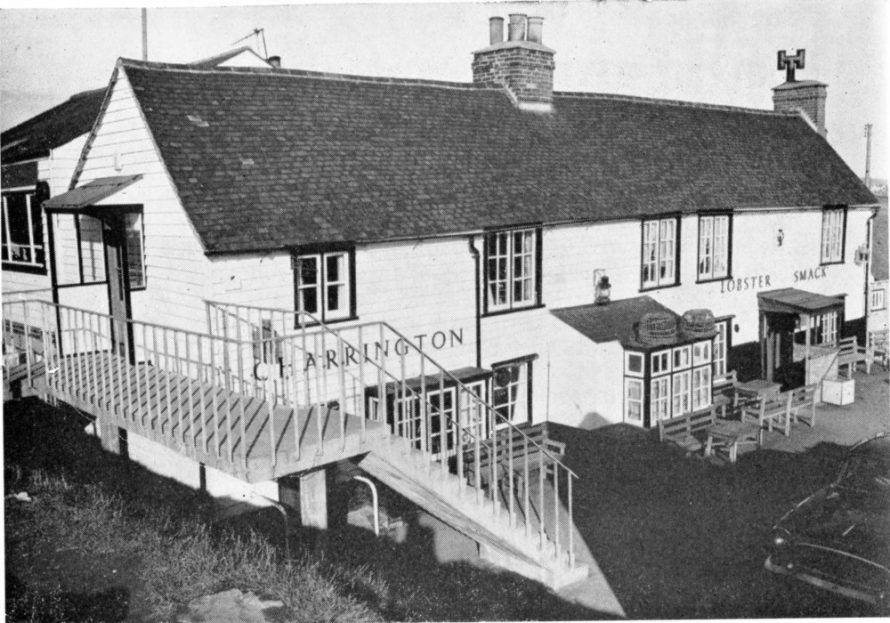
The Lobster Smack
For yet a further section of the community there was, of course, the public houses, the most famous, of course, being the “Lobster Smack” of which much has been written and is mentioned in “Great Expectations” and was the scene of many a prize fight. Although not as famous but equally well known locally was “The Red Cow“, at the Village, which faced the village pump, and was a favourite meeting place for many inhabitants. The landlord in those days was a Mr. Bill Stamford who combined his trade with that of an undertaker. “The Red Cow” was demolished and rebuilt on its present site in the late 1930s. It was the headquarters for the army during their assistance to Canvey in the 1953 floods for which they used the code name “Canute”, and, thereafter the Red Cow was renamed the “King Canute”.”The Haystack” was another centre of great social activity and the late John Delaway and his wife were “the owners and hosts. Mr. Delaways’ activities extended to horse racing. Mr. Delaway lived in a property in Long Road opposite “The Haystack” and behind his house was a large tract of land which he owned and on which he had erected around the perimeter a rail so that he could use it for his horses, and hence it acquired the name “The Paddocks”. Although the Council had, of course, no interest in horse racing as such they always saw “The Paddocks” in the centre of the Island as a useful amenity area, and eventually they were able to acquire the ground and it became a recreation ground to serve the centre of the Island and the then growing population.
The Council were continuing their policy of improving the roads on the Island and just prior to the 1939 War, Haven Road, which like so many others, was a farm track, was improved and widened into the concrete carriageway that it is today. This, of course, meant the removal of the old village well and shelter opposite the old Red Cow, and although great efforts were made by the Council to preserve the old shelter it just unfortunately fell to pieces. The 1939/45 War, of course, brought a halt to the activities of the Council and was common to the rest of Great Britain. The district itself saw the evidence of War in that heavy guns were placed in position by the War Department on the sea front near what is now known as Thorney Bay Holiday Camp and this gun site acquired the name locally of the Fort. In addition sites that the local population had regarded as purely farm land, such as Chambers Farm (which now houses the housing estate) was the site of anti-aircraft implacements. However, those days passed and the Council after the War took up again their duties to improve the lot of the community and they decided in 1946 for the very first time to build Council Houses. They engaged a firm of consultants by the name of Cockrill and Fowlers and the first relatively small estate of houses in Thameside Crescent and North Avenue were constructed. Since then, of course, the Council’s housing policy has grown in momentum and apart from the Dagenham and Walthamstow Estate, already mentioned, the Council have built over 1500 houses. At this point of time many of the present senior Officers who have served the Council and community well over the years were just joining the staff, particularly such officers as Major Stevens, to whom reference has already been made, Mr. Foyster the Deputy Engineer and Surveyor, Mr. J. F. Rumble, the Clerk, and Mr. Legg the Chief Public Health Inspector, who has since retired. Mr. John Cook, the present Chief Public Health Inspector, was for many years Mr. Legg’s deputy and indeed has been with the Council since leaving school. Mr. Johnson the Rating Officer also joined the staff not long after the War and still holds the position of Rating Officer although he has since also been made Deputy to Mr. Sharples the Treasurer.
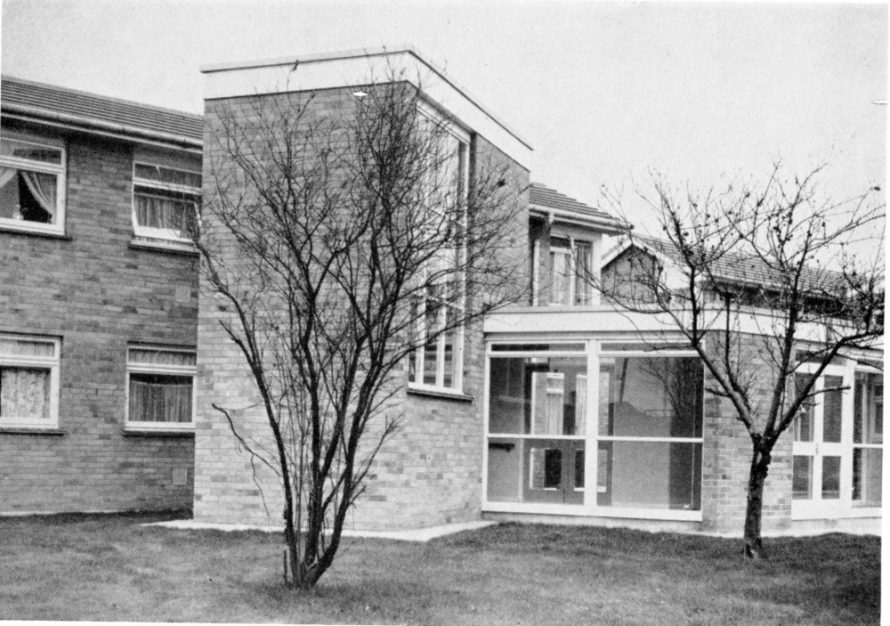
Beatrice Littlewood House Centre
The Council have always been concerned about the welfare of its folk and not the least the old people, and after the War they acquired the cookhouse and the more permanent buildings at the Gun Site at Little Gypps Farm, known locally as Chambers Farm, for housing purposes, and subsequently converted these buildings into accommodation for aged persons together with a community centre which they dedicated to the honour of Councillor George Pickett, who has been a Councillor more or less since the inception of this district with its urban powers and is still a Councillor today and is one of the representatives on the County Council. It was largely through the efforts of Councillor Pickett that the Council were able to acquire the site for their next aged persons home, namely, Beatrice Littlewood House in Kitkatts Road. This was a very fine building with superb grounds which had been originally planned by Lt. Col. Fielder, but he sold it to another well known local person, Mr. Charles Neale senior. He and his wife resided there for many years and when they decided to sell they very generously gave the Council the opportunity of acquiring it for the aged persons home at a reasonable price. The Council have always been proud of this development, which they dedicated in honour of another well known person, Mrs. Beatrice Littlewood, who served this district for many years as a Councillor. A further home was added in New Road which was again dedicated in honour of a person who had served the district well over the years as a Councillor, namely, Mrs. Amelia Blackwell. The Council acquired another property in Furtherwick Road known as “Willalla”. This was constructed in the late 1930s by Mr. and Mrs. Manthorpe and housed a billiard hall and tennis courts which were quite a focal point for social activities in the years prior to the War. This property was recently developed for the latest of their aged persons homes, and at the wish of Mrs. Manthorpe they retained the name of “Willalla” for its association with the history of Canvey Island.
Perhaps the greatest source of controversy after the 1939/45 War was the form of dedication to those who had lost their lives in the War. A public fund was started by the then Chairman of the Council, Councillor Fred Leach, another well known character who served the Island for many years in all its aspects, particularly as a Councillor.
The public decided that the fund should be used for the erection of a community hall dedicated to the memory of those who died in the 1939/45 War and the building which was constructed in the High Street was designed by Major Stevens, the Engineer and Surveyor to the Council, and the first Trustees were the then Clerk to the Council, Mr. R. Whitley, Mr. Leach and Mrs. Edith May Fisk. This being erected by public subscription it is not operated by the Council and its management and efficient running is entirely in the hands of a management committee who are elected by the public. The Council over the years have made donations towards the upkeep and maintenance of the building. The War Memorial Hall is associated with another piece of local history in that it was opened on Saturday 31 January, 1953, at 3 p.m. the opening ceremony being performed by Sir Bernard Braine, M.P. who was the then Member of Parliament for this area and still is today. Within less than 24 hours the Island was flooded by the 1953 east coats floods to which reference has already been made and the War Memorial Hall was one of the rest centres opened to relieve those who suffered as a result of the floods despite the fact that it had suffered some flooding itself. Little did those who were present at 3 p.m. at this ceremony realise the events that were to come within the next 24 hours and the use to which the hall would be first put.
That the Council over the years have always taken an interest in the well being of its inhabitants is further shown by the fact that when the senior citizens formed a Committee under the chairmanship of Mr. Harry Whitcomb, who was at that time a Councillor, to establish a centre for the senior citizens, the Council very generously leased a site at The Paddocks at a peppercorn rent and gave a donation of some £6,000 towards the building and furnishing costs, and the Centre is now an accomplished fact. The Council of course, are not responsible for the running or maintenance of this building, this being the sole responsibility of the senior citizens Committee.
The Council, of course, have never been its own transport authority but, nevertheless, because the only railway station situate at Benfleet is some distance, every Member over the years has taken a lively interest in the forms of public transport from the Island to the Station. Prior to the opening of the bridge there were one or two pony and traps with such operators as Vic Crow and Vic Scott. Subsequently one or two private buses came on the scene, one of which was operated by the present vice Chairman of the Council, Councillor H. A. Tibbles who has done yeoman service to the district over the years apart from his being one of the first bus operators. Councillor Tibbles operated this bus service with the help of Harry Gaylard. Other contemporaries of Bert Tibbles as bus operators were McDermot Rowe, Fraser Nash and Nicholls and Hiscock, all of whose buses, of course, were single deckers. The prices, of course, were not controlled by any statutory body or watched over as they are these days by the Local Authority, and it was not unknown to be charged the sum of 2/6d from the ferry to Leigh Beck which was rather an exorbitant price in those days. Subsequently a private company was formed by Mr. Bridge who ran the Canvey and District Motor Company with a regular service and he operated a shuttle service from Leigh Beck to’the bridge. With the construction of the underpass at Benfleet Station some 10 years or so ago, the shuttle service became a through service to Southend and Mr. Bridge sold out his interest to a larger concern which is now part of the Eastern National Omnibus Company.
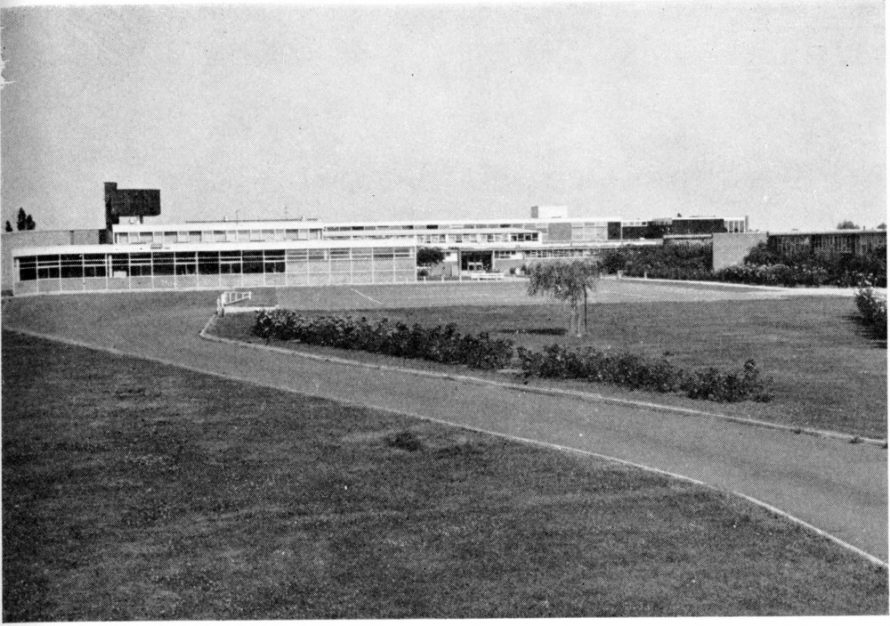
Furtherwick Park Comprehensive School
A brief mention has been made of the Council’s interest in education and their efforts in establishing the first school in Long Road. The Council’s interest did not, of course, stop there particularly when Mr. William Read was appointed as Headmaster and became actively associated with the district by becoming a Member of the Council. With the growth in population it became vital for further schools to be established and the next project which the Council were instrumental in was persuading the Essex County Council as the Education Authority to construct the Leigh Beck School for infants and juniors. Prior to that the only education facility at the eastern end had been the use of Whittier Hall as an infants school, although one should not forget the sterling work undertaken in this direction by Miss Gwen Evans who ran a private school at Kingsley Hall in Central Wall Road. The Leigh Beck School under its popular headmistress, Miss Vincent could satisfy for the time being the needs of the eastern end of the Island but the educational needs of the western end became somewhat neglected and again after pressure on the Essex County Council to establish a school nearer the Village, the Long Road Junior School was opened and for many years the Headmaster of this school was Mr. Benson who was a particularly popular figure in the district. In the latter years the Essex County Council have not only extended these three schools and have indeed rebuilt the William Read School, but have provided a Comprehensive School at Furtherwick Park over which Mr. Watkins for many years has presided, and have more recently opened the Northwick Park School and the Cornelius Vermuyden Comprehensive School in the Winter Gardens. They are also planning a further junior school in the Winter Gardens and a Church of England Primary School.
No Council could feel that it had achieved its community purpose without the provision of recreation grounds, and apart from The Paddocks which has already received mention, the Council were very fortunate when the A. M. Clark Estate, through Mr. Lawrence who was a great benefactor of the district, made a gift to the Council of land at Leigh Beck which is known as the Leigh Beck Recreation Ground, and this was railed off with stout iron fencing and housed football and cricket pitches together with children’s amusements and was a great centre of attraction to the eastern end of the Island. The railings disappeared in the drive for scrap in the War Years and have never been replaced and a large portion of the earth from the southern end of the land was taken to restore the sea walls after the 1953 floods. The Council are grading and partly filling in this excavation and they hope that over the years this recreation ground can be restored to its former state. These two grounds, however, were not sufficient for the public and some 15 years ago the Council acquired further land in Poplar Road for the establishment of a recreation ground, this time to include tennis and football together with cricket pitches and established the King George’s Playing Field. With an eye to the future and realising that urbanisation was fast spreading to Canvey Island, the Council, largely due to the efforts of their Clerk, Mr. John Rumble, were able to acquire Waterside Farm which consisted of 200 or more acres plus many acres of saltings. This is gradually taking shape with the provision of football, rugby and cricket plus the erection of a nine hole golf course and the commencement of the latest venture — a sports complex designed by the Deputy Engineer and Surveyor, Mr. R. C. Foyster. This will house not only a sports complex but a swimming pool and this project together with the planting of trees and shrubs and the wide open spaces spreading from Canvey Road to Tewkes Creek, is in the view of the Council one of the finest projects they have ever undertaken in their comparatively short history.
It had long been the wish of the Council to provide a community centre, and although the controversy raged for many years on the way it should be done, whether it should be part of a sports complex or a separate building and where it should be sited some two years ago the decision was finally taken to build it as a separate project and to establish it in The Paddocks as being in the centre of the Island and accessible to everyone. This building, designed by the Engineer and Surveyor, Major Stevens, should be ready some time in 1973. Again the Council look at this as a great achievement and fulfilling the ambitions of many Councillors who have served this district.
No notes on the history and achievements of the Canvey Island Urban District Council would be complete without a particular mention of Councillor George Pickett. He has been a Member of the Council virtually since its inception in 1926 and is elected to serve until the Urban District Council ceases in April 1974. George Pickett has proved an able, experienced and devoted Councillor over the years and has earned the affection and respect of Councillors of whatever political persuasion and Officers alike. Two years ago the Council took the opportunity of showing their affection and respect to George Pickett by placing a special bronze plaque depicting his likeness at the head of the main staircase in the Sydervelt Road entrance to the Council Offices. This was unveiled at a special ceremony held in the Council Offices to which all sections of the community were invited. Councillor Pickett has also represented Canvey at many meetings and conferences in every part of the country and his name is synonymous with Canvey.
Mention must also be made of some of the men and women who have given up their time to serve the community as Councillors. It is not possible to mention every name, apart from those already mentioned, many of the older residents will remember with affection such names as: Ted Nightingale, Charlie Paice, Sam Girling, Grandfather Chambers, Mrs, Elkington, Harry George, Monty Hartfield, Frank Wade, — Franke, Herbert Dellaway, John Longman, Clara James, Frank Marsh, Bill Johnston, Connie Johnston, Oliver Togni, Katie Cuthbert, Arthur Joyce, Ernest Shillum, Mrs. Powell, James Galvin, Bill Affleck, Arthur Fuller, Sam Marsom, Tamburro, Ethel White, Ernest Norman, Len Cook, Roy Cook, Chas. Fitzpatrick, Don Holdaway, Chris Yates, Charlie Lam-pard. Bob Wilson, Ken Wright, Bert Grout, Alf Yorwarth, George Wall, Mrs. Davies, Chris Morgan, John Collisson, Alan Boss, Ted Bones, Bill Ashworth, Tony Allen and Arthur Bishop.
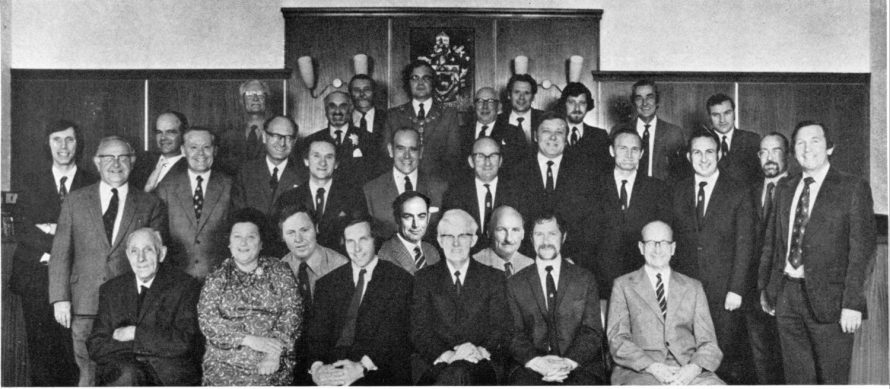
BACK ROW: Councillor R. S. Ives, Councillor S. Alterman, J .Rumble (Clerk of the Council), Councillor D. Allen (Chairman), Councillor H. A. Tibbles (Vice-Chairman), Councillor W. R. MacDonell, Councillor B. A. Beasley, Councillor W. H. Balch, Councillor F. P. Wood.MIDDLE ROW: R Raymond (Committee Clerk), R .C. Foyster (Deputy Engineer & Sur¬veyor), I. Campbell (Chief Committee Clerk), E. R. Hawkins (Chief Assistant Treasurers Dept.), L. Lock-Dingley (Deputy Clerk), Councillor J. W. Bowden, Councillor G. W. Black-well, A. P. J. Cook (Chief Public Health Inspector), Councillor T. M. Fletcher, P .H. Ritson (Deputy Public Health Inspector), J. Peters (Senior Administrative Assistant), F. Wall (Works Study Officer), Councillor H. W. King. FRONT ROW: Councillor G. A. Pickett, Councillor Mrs. D. E. Shaw, Councillor R. Howard, Councillor A. J. W. Hurd, H. Sharpies (Treasurer), Councillor M. F. Luker, R. H. Stevens, (Engineer & Surveyor). Councillor A. Ingold. F. Streatfield (Housing Manager)
As a tribute to those Councillors and the staff who have served under them appended below is a list of all the Chairmen since the inception of the Council in 1926 to this present day together with their Chief Officers and Deputies (in the gallery below):—
| Councillor | Bensley: | 1926/1929 |
| Councillor | G. H. J. Chambers: | 1929/1930 |
| Councillor | F. J. Leach: | 1930/1934 |
| Councillor | G. H. J. Chambers: | 1934/1936 |
| Councillor | J. E. Longman: | 1936/1938 |
| Councillor | F. J. Leach: | 1938/1939 |
| Councillor | G. A. Pickett: | 1939/1941 |
| Councillor | E. Rayment: | 1941/1944 |
| Councillor | F. J. Leach: | 1944/1946 |
| Councillor | A. C. Mason: | 1946/1947 |
| Councillor | G. A. Pickett: | 1947/1948 |
| Councillor | H. P. Fielder: | 1948/1951 |
| Councillor | A. C. Mason: | 1951/1952 |
| Councillor | F. J. Leach | 1952/1953 |
| Councillor | E. G. Nightingale: | 1953/1954 |
| Councillor | Mrs. D. G. Elkington: | 1954/1955 |
| Councillor | H. P. Fielder: | 1955/1957 |
| Councillor | A. C. Mason: | 1957/1958 |
| Councillor | E. E. Norman: | 1958/1959 |
| Councillor | H. C. Whitcomb: | 1959/1960 |
| Councillor | G. A. Pickett: | 1960/1961 |
| Councillor | G. H. Prince: | 1961/1962 |
| Councillor | G. Blackwell: | 1962/1963 |
| Councillor | S. Alterman: | 1963/1964 |
| Councillor | H. Whitcomb: | 1964/1965 |
| Councillor | G. A. Pickett: | 1965/1966 |
| Councillor | G. A. Pickett: | 1966/1967 |
| Councillor | G. Blackwell: | 1967/1968 |
| Councillor | R. Jones: | 1968/1969 |
| Councillor | H. A. Tibbles: | 1969/1970 |
| Councillor | B. A. Beasley: | 1970/1971 |
| Councillor | W. H. Ashworth: | 1971/1972 |
| Councillor | D. E. Allen: | 1972/1973 |
| Councillor | D. E. Allen: | 1973/1974 |
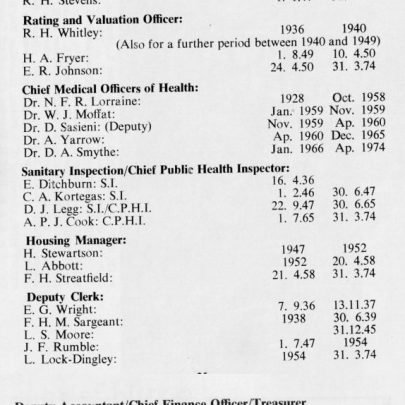




No Comments
Add a comment about this page